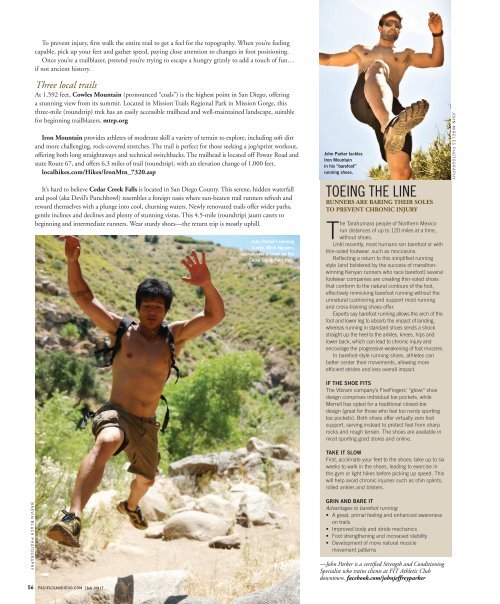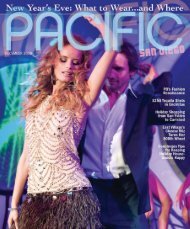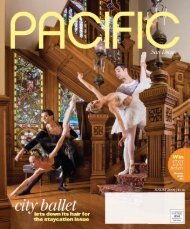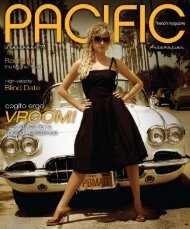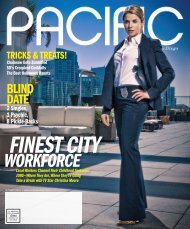currents - Pacific San Diego Magazine
currents - Pacific San Diego Magazine
currents - Pacific San Diego Magazine
Create successful ePaper yourself
Turn your PDF publications into a flip-book with our unique Google optimized e-Paper software.
To prevent injury, first walk the entire trail to get a feel for the topography. When you’re feeling<br />
capable, pick up your feet and gather speed, paying close attention to changes in foot positioning.<br />
Once you’re a trailblazer, pretend you’re trying to escape a hungry grizzly to add a touch of fun…<br />
if not ancient history.<br />
Three local trails<br />
At 1,592 feet, Cowles Mountain (pronounced “coals”) is the highest point in <strong>San</strong> <strong>Diego</strong>, offering<br />
a stunning view from its summit. Located in Mission Trails Regional Park in Mission Gorge, this<br />
three-mile (roundtrip) trek has an easily accessible trailhead and well-maintained landscape, suitable<br />
for beginning trailblazers. mtrp.org<br />
Iron Mountain provides athletes of moderate skill a variety of terrain to explore, including soft dirt<br />
and more challenging, rock-covered stretches. The trail is perfect for those seeking a jog/sprint workout,<br />
offering both long straightaways and technical switchbacks. The trailhead is located off Poway Road and<br />
state Route 67, and offers 6.3 miles of trail (roundtrip), with an elevation change of 1,000 feet.<br />
localhikes.com/Hikes/IronMtn_7320.asp<br />
It’s hard to believe Cedar Creek Falls is located in <strong>San</strong> <strong>Diego</strong> County. This serene, hidden waterfall<br />
and pool (aka Devil’s Punchbowl) resembles a foreign oasis where sun-beaten trail runners refresh and<br />
reward themselves with a plunge into cool, churning waters. Newly renovated trails offer wider paths,<br />
gentle inclines and declines and plenty of stunning vistas. This 4.5-mile (roundtrip) jaunt caters to<br />
beginning and intermediate runners. Wear sturdy shoes—the return trip is mostly uphill.<br />
John Parker’s running<br />
buddy, Minh Nguyen,<br />
bounds over a brook on the<br />
Cedar Creek Falls trail.<br />
John Parker tackles<br />
Iron Mountain<br />
in his “barefoot”<br />
running shoes.<br />
Toeing the Line<br />
Runners are baring their soles<br />
to prevent chronic injury<br />
T<br />
he Tarahumara people of Northern Mexico<br />
run distances of up to 120 miles at a time,<br />
without shoes.<br />
Until recently, most humans ran barefoot or with<br />
thin-soled footwear, such as moccasins.<br />
Reflecting a return to this simplified running<br />
style (and bolstered by the success of marathonwinning<br />
Kenyan runners who race barefoot) several<br />
footwear companies are creating thin-soled shoes<br />
that conform to the natural contours of the foot,<br />
effectively mimicking barefoot running without the<br />
unnatural cushioning and support most running<br />
and cross-training shoes offer.<br />
Experts say barefoot running allows the arch of the<br />
foot and lower leg to absorb the impact of landing,<br />
whereas running in standard shoes sends a shock<br />
straight up the heel to the ankles, knees, hips and<br />
lower back, which can lead to chronic injury and<br />
encourage the progressive weakening of foot muscles.<br />
In barefoot-style running shoes, athletes can<br />
better center their movements, allowing more<br />
efficient strides and less overall impact.<br />
IF THE SHOE FITS<br />
The Vibram company’s FiveFingers’ “glove” shoe<br />
design comprises individual toe pockets, while<br />
Merrell has opted for a traditional closed-toe<br />
design (great for those who feel too nerdy sporting<br />
toe pockets). Both shoes offer virtually zero foot<br />
support, serving instead to protect feet from sharp<br />
rocks and rough terrain. The shoes are available in<br />
most sporting good stores and online.<br />
john mireles photography<br />
brevin blach photography<br />
56 pacificsandiego.com {July 2011}<br />
TAKE IT SLOW<br />
First, acclimate your feet to the shoes: take up to six<br />
weeks to walk in the shoes, leading to exercise in<br />
the gym or light hikes before picking up speed. This<br />
will help avoid chronic injuries such as shin splints,<br />
rolled ankles and blisters.<br />
GRIN AND BARE IT<br />
Advantages to barefoot running<br />
• A great, primal feeling and enhanced awareness<br />
on trails<br />
• Improved body and stride mechanics<br />
• Foot strengthening and increased stability<br />
• Development of more natural muscle<br />
movement patterns<br />
—John Parker is a certified Strength and Conditioning<br />
Specialist who trains clients at FIT Athletic Club<br />
downtown. facebook.com/johnjeffreyparker


